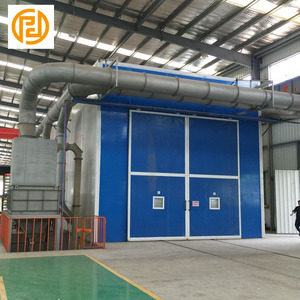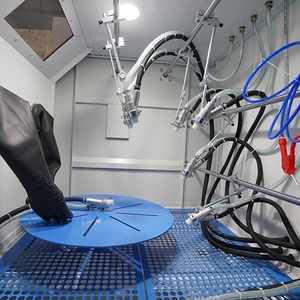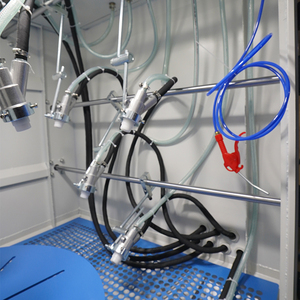
All categories
Featured selections
Trade Assurance
Buyer Central
Help Center
Get the app
Become a supplier

(3039 products available)




















Sand blasting rooms are available in various types to suit different industrial applications. The following are some of the common types of sand blasting booths.
An open blasting system is the most basic type of sand blasting booth. It consists of a simple, open workstation with walls or barriers. The barriers are usually lower than the ceiling height to allow easy access and movement of the workpiece and operator. Open blasting systems are suitable for small-scale blasting tasks. They are affordable and easy to set up and maintain.
Blast rooms are large, enclosed spaces where sand blasting operations are carried out. They have full ceiling heights, and the walls are designed to withstand the abrasive impact. Blast rooms are suitable for large-scale or high-production blasting applications. They provide ample space for workpieces of various sizes, and they offer containment of the abrasive material and dust within the room.
An automated sand blasting room features advanced robotics and automated systems for handling workpieces. Automated sand blasting rooms can execute blasting tasks with high precision and consistency. They are suitable for integration into production lines where efficiency and automation are required.
Portable blasting systems are designed to be movable so they can be easily transported to different work sites. They may be mounted on wheels or a cart for portability. Portable sand blasting booths offer flexibility for on-site maintenance and repair jobs. They can also be used for occasional or temporary blasting needs. When not in use, the portable blaster can be stored in a garage or workshop.
Below are some specifications of a sand blasting room:
Size: Sand blasting rooms come in different lengths, widths, and heights. The size of the sand blasting room is measured in either meters or feet.
Components: A normal sand blasting room comes with a door, a dust removal system, a lighting system, a workpiece transport system, and a separator. Also, it is divided into three parts: the blasting area, the abrasive recovery system, and the dust collection system.
Lighting: Sand blasting rooms come with different types and sizes of lights. The lighting system used in a sand blasting room has a direct impact on the quality and efficiency of the blasting operation.
Workpiece transport system: This is the method used in moving the workpiece into the blasting chamber and out of it after the blasting operation. Conveyor belts and roller conveyors are used as workpiece transport systems in a sand blasting room.
Dust collection system: The dust collection system in a blasting room is used to remove debris and dust from the blasting process. The dust collection system in a sand blasting room is made up of a filter or a cyclone separator.
Separator: This is a device used to remove sand or other abrasive substances from the compressed air. The separator in a sand blasting room is available in different types, including water separators and oil separators.
Abrasive: The common types of abrasives used in a sand blasting room include steel grit, steel shot, aluminum oxide, glass beads, and silicon carbide.
Here are some maintenance tips for a sand blasting room:
Users should always clean the abrasive and change it at regular intervals to prevent the buildup of dust and debris. This process will help maintain the efficiency and performance of the blasting operation.
Inspect the abrasive blasting equipment for wear and tear. If there are any damages or defects, repair or replace them immediately. Regular maintenance of the sand blasting room can help minimize the risk of costly repairs and downtime.
Regularly inspect and clean the dust collection system in the sand blasting room. This will help prevent the buildup of dust and debris, which can lead to poor air quality and potential safety hazards.
Manufacturers can recommend a maintenance schedule and best practices for the specific type of sand blasting room being used. Users should follow the manufacturer's guidelines to ensure proper maintenance and optimal performance.
A sand blasting room is commonly used in many sectors. Below are some application scenarios of the machine:
In the automotive industry, a blasting room is used to remove paint, rust, scale, and other contaminants from the surface of auto parts. Moreover, it can be used to prepare car bodies and components for painting, coating, or refinishing. The blasting room can help to improve the adhesion of new finishes and enhance the durability of automotive components.
In the construction industry, a blasting room can be used to clean, etch, or texture various construction materials. It includes concrete panels, bricks, and stones. Besides, it can prepare surfaces for painting, sealing, or bonding in construction projects. A blasting room can help to achieve better surface adhesion and improve the aesthetic quality and durability of construction materials.
A blasting room can be used to remove oxide layers, burrs, and contaminants from the surface of aerospace components. It includes aircraft frames, engine parts, and landing gear. Additionally, it can be used to prepare surfaces for bonding or coating to ensure the reliability and safety of aerospace equipment.
In the marine industry, a blasting room can be used to remove marine growth, rust, and old coatings from ship surfaces and equipment. Also, it can be used to clean and prepare surfaces for new coatings to protect ships from corrosion and prolong their service life. Besides, a blasting room can be used for shipbuilding and maintenance to ensure the structural integrity and performance of marine vessels.
A blasting room can be used to create artistic effects or restore sculptures. It can be used to carve, engrave, or shape various materials for artistic creation. Also, it can be used to remove dirt, corrosion, or unwanted deposits from artworks. A blasting room is suitable for artists and restoration professionals who need to achieve precise and delicate results in their work.
A blasting room can be used in the electronics industry to clean and etch electronic components. It includes circuit boards, semiconductor chips, and thin-film materials. Also, it can be used to remove insulation layers or select material surfaces for electronic component manufacturing. Besides, it can be used for surface treatment to improve the adhesion and conductivity of electronic components.
Consider the typical sizes of the workpieces or materials, as well as the overall workload. If there are large-scale items or a high volume of workpieces, it is necessary to choose a sand blasting room that can meet the production capacity.
Determine the required surface treatment effect. If the surface of the workpiece requires a very high-quality finish and uniformity, choose a sand blasting room with precise control over parameters such as abrasive material, pressure, and nozzle movement.
If it is necessary to improve work efficiency and production capacity, it is essential to choose a sand blasting room with high system efficiency. Consider the loading and unloading process, the blasting speed, and the overall workflow to ensure smooth production.
Consider the operating environment and safety requirements. Choose a sand blasting room with appropriate dust removal and ventilation systems to ensure operator safety and environmental compliance.
Consider the long-term cost and maintenance requirements of the sand blasting room. Choose a model with good abrasion resistance and corrosion resistance, which can reduce the frequency of maintenance and maintenance costs in the future.
Q1: What is the purpose of a sand blasting room?
A1: The main purpose of a sand blasting room is to provide a controlled and contained environment for sandblasting, which includes the preparation, cleaning, and surface treatment of the workpiece. It can also offer safety features to protect workers and the surrounding environment.
Q2: What is the proper way to maintain a sand blasting room?
A2: Regular maintenance is important to ensure the efficient operation of the sand blasting room. It is essential to conduct regular inspections of the equipment and components to identify any signs of wear, damage, or blockage. Keep the inside of the room clean. Make sure the ventilation system is working correctly.
Q3: Can items like large machinery, vehicles, and parts be put in a blasting room?
A3: Yes, sand blasting rooms are large enough for items like machinery, vehicles, and parts. In fact, they are commonly used in industries like the automotive, manufacturing, and construction industries.